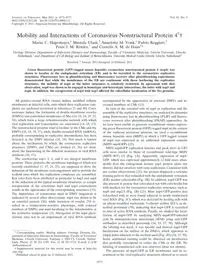
2011 Mobility and Interactions of Coronavirus Nonstructural Protein 4 PDF
Preview 2011 Mobility and Interactions of Coronavirus Nonstructural Protein 4
JOURNAL OF VIROLOGY, May 2011, p. 4572–4577 Vol. 85, No. 9 0022-538X/11/$12.00 doi:10.1128/JVI.00042-11 Copyright © 2011, American Society for Microbiology. All Rights Reserved. Mobility and Interactions of Coronavirus Nonstructural Protein 4�† Marne C. Hagemeijer,1 Mustafa Ulasli,2 Annelotte M. Vonk,1 Fulvio Reggiori,2 Peter J. M. Rottier,1 and Cornelis A. M. de Haan1* Virology Division, Department of Infectious Diseases and Immunology, Faculty of Veterinary Medicine, Utrecht University, Utrecht, Netherlands,1 and Department of Cell Biology and Institute of Biomembranes, University Medical Centre Utrecht, Utrecht, Netherlands2 Received 7 January 2011/Accepted 14 February 2011 Green fluorescent protein (GFP)-tagged mouse hepatitis coronavirus nonstructural protein 4 (nsp4) was shown to localize to the endoplasmic reticulum (ER) and to be recruited to the coronavirus replicative structures. Fluorescence loss in photobleaching and fluorescence recovery after photobleaching experiments demonstrated that while the membranes of the ER are continuous with those harboring the replicative structures, the mobility of nsp4 at the latter structures is relatively restricted. In agreement with that observation, nsp4 was shown to be engaged in homotypic and heterotypic interactions, the latter with nsp3 and nsp6. In addition, the coexpression of nsp4 with nsp3 affected the subcellular localization of the two proteins. All positive-strand RNA viruses induce modified cellular membranes in infected cells, onto which their replication com- plexes are anchored (reviewed in references 23 and 30). Coro- naviruses induce the formation of double-membrane vesicles (DMVs) and convoluted membranes (CMs) (14, 18, 24, 29, 32, 34), which form a large reticulovesicular network with which viral replication and transcription are associated (14, 18, 37). The nonstructural proteins (nsp’s) localize to the CMs and the DMVs (16, 18, 34, 37), while double-stranded RNA (dsRNA), probably corresponding to replicative intermediates, has been detected at the DMV interior (18, 34). Not much is known about the mechanism by which the coronavirus replicative structures (DMVs and CMs) are formed (4, 26), let alone about the functioning of the different structures in viral RNA synthesis (18, 37). The coronavirus nsp’s 3, 4, and 6 are integral membrane proteins. These proteins, the membrane topology of which was recently established (1, 17, 24, 25), are supposed to drive the induction of the membrane rearrangements and to provide the scaffold onto which the replication complexes are assembled. Key roles have been attributed in particular to nsp3 and nsp4 in the induction of the typical membrane structures, as ectopic coexpression of the arterivirus nsp3 and nsp4 counterparts results in the appearance of the corresponding structures (35). The importance of coronavirus nsp4 in DMV biogenesis is indicated by several other observations. nsp4 was shown to be an essential protein (36), while mutation of residue 258 re- sulted in a temperature-sensitive phenotype, with reduced numbers of DMVs and nsp4 localizing to the mitochondria at the restrictive temperature (3). Abrogation of the nsp4 glyco- sylation sites led to an impairment of viral RNA synthesis accompanied by the appearance of aberrant DMVs and in- creased numbers of CMs (13). In view of the essential role of nsp4 in replication and the assembly of the replicative structures, we analyzed its dynamics using fluorescence loss in photobleaching (FLIP) and fluores- cence recovery after photobleaching (FRAP) approaches. As we have been unable to generate recombinant viruses express- ing green fluorescent protein (GFP)-tagged nsp4 in the context of the replicase precursor proteins, we used a recombinant mouse hepatitis virus (MHV) in which a GFP-tagged version of nsp4 was expressed as an additional expression cassette (MHV-nsp4GFP) (25). MHV-nsp4GFP replication kinetics and peak titers in LR7 cells were similar to those of recombinant wild-type MHV (MHV-WT) (5) (Fig. 1A). Apparently, expression of nsp4- GFP, which was expressed approximately 12-fold more abun- dantly than the endogenous mature nsp4 protein (data not shown), did not interfere with virus replication. Consistent with our earlier observations (25), the protein displayed a reticular staining pattern that coincided with the endoplasmic reticulum (ER) marker calreticulin (Fig. 1B). In addition, nsp4-GFP was also present in puncta that colocalized not with calreticulin but with markers for the coronavirus replicative structures, such as nsp8 and nsp2/3 (Fig. 1B) (25). Most nsp4-GFP-positive foci colocalized with or were found adjacent to newly synthesized viral RNA (Fig. 1C), which was detected by feeding cells with an alkyne-modified nucleoside, 5-ethynyl uridine (EU), as de- scribed previously (39), indicating that nsp4-GFP is recruited to sites of active RNA synthesis. Finally, we studied the local- ization of nsp4-GFP by analyzing MHV-nsp4GFP-infected cells by immunoelectron microscopy (IEM) using anti-GFP antibodies as described previously (16, 33, 37, 38). Although the labeling was weak, it was specific and showed nsp4-GFP localization on the surface of the DMVs, which appeared as empty holes inherent to the method used (Fig. 1D) (16, 37, 39). Some additional staining could be observed on membranes that probably correspond to either the CMs or the ER. No labeling of noninfected cells was observed (data not shown). The presence of nsp4-GFP in ER membranes and its re- cruitment to the viral replicative structures allowed us to assess * Corresponding author. Mailing address: Virology Division, De- partment of Infectious Diseases & Immunology, Faculty of Veterinary Medicine, Utrecht University, Yalelaan 1, 3584 CL Utrecht, Nether- lands. Phone: 31 30 253 4195. Fax: 31 30 253 6723. E-mail: C.A.M
